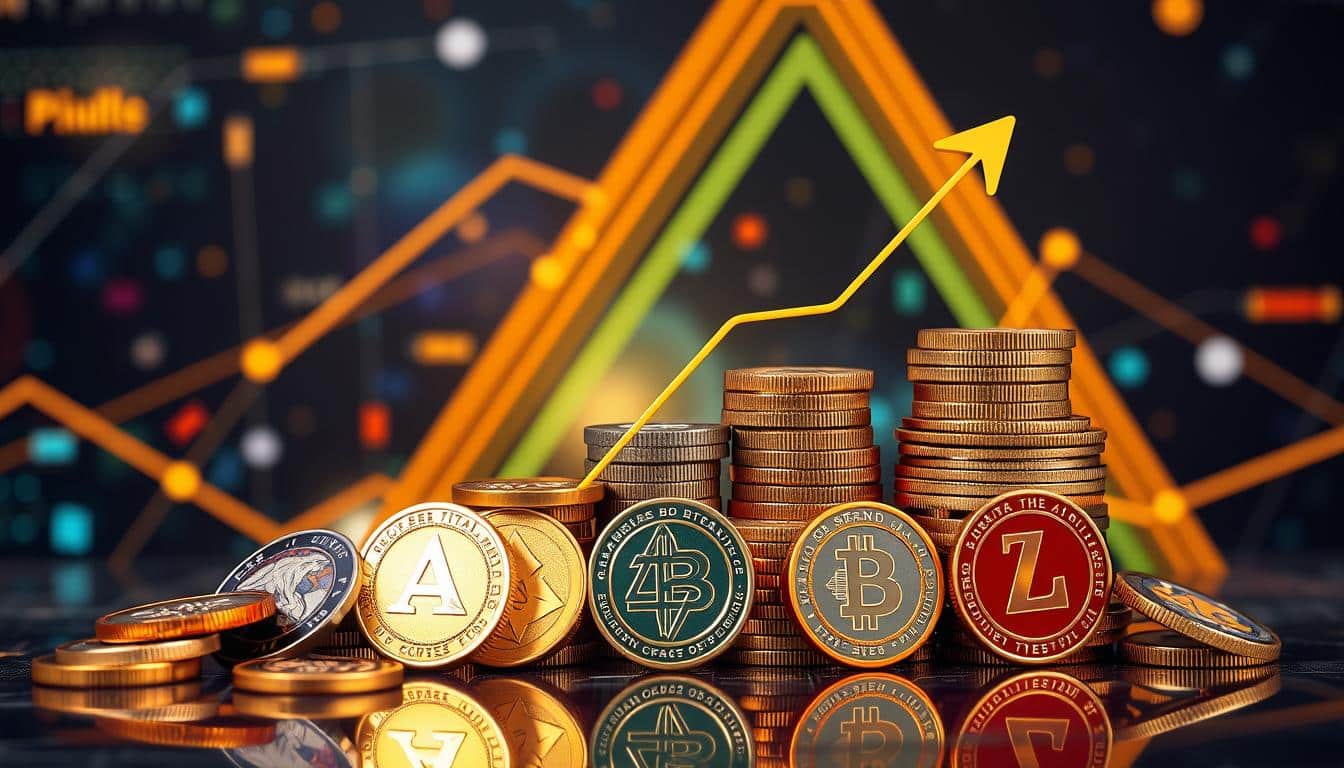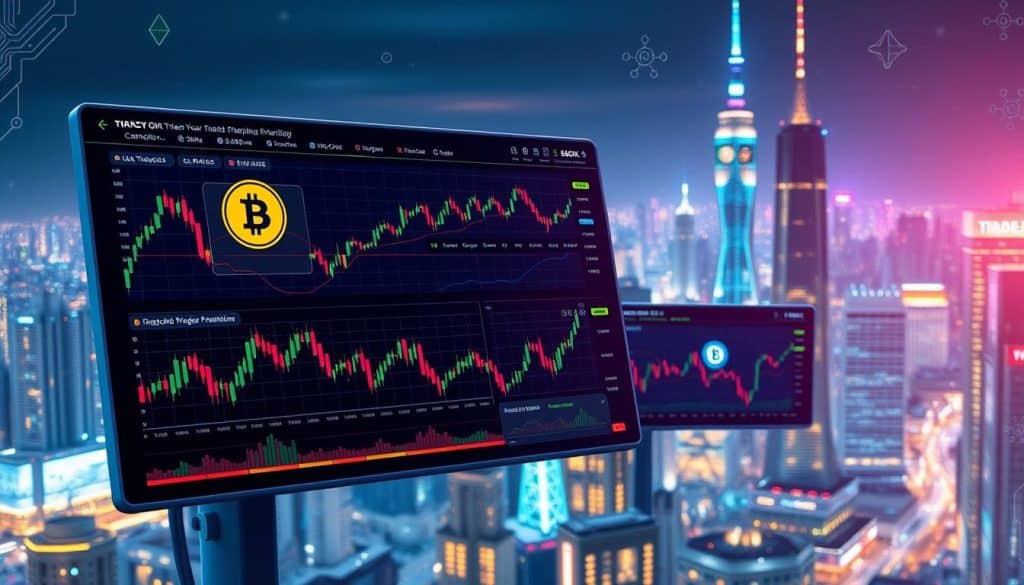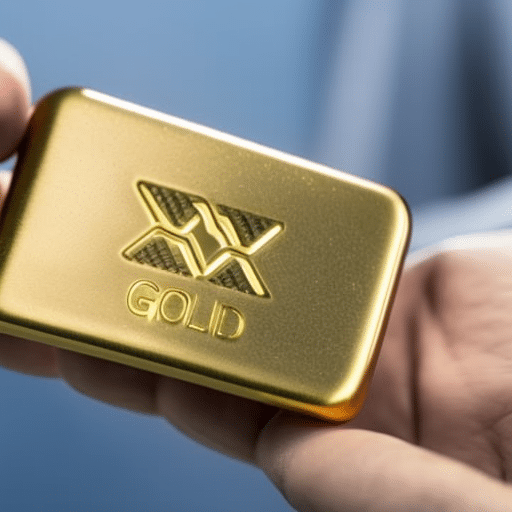Top Altcoins List: Explore Crypto Alternatives
Did you know altcoins form a huge part of the $2.4 trillion cryptocurrency market? Bitcoin is the top dog, but currencies like Ethereum, Binance Coin, and Solana are quickly making a name for themselves1. If you’re looking into crypto alternatives, you’ve come to the right spot. Getting to know different altcoins can expand your crypto knowledge and possibly lead to profitable investments.
Let’s dive deep into the world of top altcoins showing strong market growth and unique features. From Ethereum’s smart contract powers to Solana’s fast transactions, each altcoin has its special offer apart from Bitcoin. Join us to discover the intrigue, possibilities, and standings of these amazing cryptocurrencies.
Key Takeaways
- Altcoins make up a big chunk of the $2.4 trillion cryptocurrency market cap1.
- Ethereum is a leader in smart contract tech with a market cap of $418.9 billion2.
- Binance Coin is the utility token of the world’s biggest cryptocurrency exchange by daily trading volume1.
- Solana offers quick transactions and low fees with its hybrid consensus mechanism1.
- Stablecoins like Tether and USD Coin are stable, tied 1-to-1 with the U.S. dollar1.
Ready for a deeper look? Visit our top crypto picks to stay on top of the altcoin market. Whether you’re a newbie or a seasoned investor, getting to know these alternatives can boost your financial choices.
Introduction to Altcoins
Altcoins, known as alternative coins, are cryptocurrencies other than Bitcoin (BTC). They include a variety of digital assets, each with special functions. These range from DeFi apps to utility tokens, marking their spots in the crypto world.
What are Altcoins?
Bitcoin was the first, paving the way for other digital currencies called altcoins. Ethereum (ETH) brought smart contracts and dApps into the picture3. Altcoins like Litecoin (LTC) and Ripple (XRP) have their own blockchains. Others, such as USD Coin (USDC), use existing networks like Ethereum3. There are many types of altcoins, including payment tokens and meme coins, meeting diverse needs4.
The Evolution of Cryptocurrency
The crypto world has changed a lot since Bitcoin’s start. Ethereum’s smart contracts have shown new uses for blockchain3. Altcoins came about to improve on what was already there. For instance, Litecoin came from Bitcoin to process transactions faster4.
Now, there are many altcoins, each adding value to the market4. With innovations like energy-saving coins and ones that work across chains, the growth continues5.
Differences Between Bitcoin and Altcoins
Bitcoin and altcoins differ mainly in how they are used and made. Bitcoin is mainly seen as digital gold. Altcoins like Ethereum (ETH) and Cardano (ADA) help with complex apps and contracts5. Privacy-focused coins like Monero ensure your transactions stay hidden, unlike Bitcoin5. Stablecoins, pegged to real-world currencies, offer steady prices for daily use5.
Altcoins bring the chance to diversify, advance technologically, and earn well. Yet, they also carry higher risks, such as volatile prices and uncertain rules5. Sound research and smart strategy are key for altcoin investors.
| Altcoin Type | Examples | Key Features |
|---|---|---|
| Payment Tokens | Litecoin (LTC), Bitcoin Cash (BCH) | Facilitates transactions and acts as digital cash |
| Stablecoins | Tether (USDT), USD Coin (USDC) | Pegged to external assets for stability |
| Utility Tokens | Ethereum (ETH), Filecoin (FIL) | Used for specific network services |
| Meme Coins | Dogecoin (DOGE), Shiba Inu (SHIB) | Inspired by jokes, high community engagement |
| Governance Tokens | Uniswap (UNI), Maker (MKR) | Enables voting rights within protocols |
Ethereum (ETH): The Smart Contract Pioneer
Ethereum leads the way in the blockchain space with smart contracts. This innovation has changed how decentralized apps (dApps) are created and used. As the second-biggest crypto by market size, Ethereum is key in decentralized finance and Web3 solutions.
Overview of Ethereum
Vitalik Buterin launched Ethereum in 2015. It’s different from Bitcoin, focusing not just on digital currency but on allowing smart contracts and dApps to run without any problems, fraud, or control. ETH, its currency, is used for paying fees and services on its network. Ethereum is moving to Ethereum 2.0, which will improve scalability, security, and sustainability67.
Ethereum’s Role in Decentralized Finance
Ethereum is crucial for decentralized finance (DeFi) projects, offering the base for services like lending and trading directly between people6. With smart contracts, it cuts out the middlemen, like banks. This makes DeFi more efficient and cheaper. Thus, Ethereum is at the heart of DeFi, pushing forward innovation and creating new, open financial products7.
Why Invest in Ethereum?
Investing in Ethereum is appealing for several reasons. Its significant role in DeFi and smart contracts supports its value6. The shift to Ethereum 2.0 will tackle scalability problems, making it faster and greener. This could increase its use and value7. Plus, Ethereum’s applications in various fields add to its potential for long-term success. Its ongoing developments and increasing use make Ethereum a key investment for the crypto market.
Tether (USDT): The Stablecoin Leader
Tether (USDT) is a leading stablecoin in the crypto world. It provides unmatched price stability. This is because it is backed by significant fiat-collateralized reserves. So, its value stays closely linked to the U.S. dollar.
What is a Stablecoin?
A stablecoin is a kind of cryptocurrency. It aims to reduce price swings. This is done by linking its value to a reserve asset, like fiat currency or commodities. Unlike other cryptocurrencies, like Bitcoin, stablecoins keep their value constant. This makes transactions more predictable and stable.
The Mechanism Behind Tether
Tether uses fiat-collateralized reserves to keep its value equal to the USD8. Each Tether token is supported by a matching amount in U.S. dollars. These dollars are kept by Tether Limited. By August 1, 2024, Tether’s reserves and excess reserves hit $118.4 billion and $5.3 billion, respectively. This boosts the stablecoin’s trust and credibility in the market9. Additionally, Tether’s net equity is at $11.9 billion. Its market value is over $114 billion9.
Advantages of Using Tether
Tether has several benefits that make it popular among crypto traders and investors:
- Price Stability: Its most notable benefit is steady value equal to the U.S. dollar. This makes it a reliable option for transactions.
- Broad Adoption: Tether is the leading cryptocurrency by trading volume worldwide since 2019, with a 70% market share in the stablecoin sector9. As of July 2024, it has over 350 million users globally9.
- Secure Transfers: Its fiat-collateralized reserves help maintain its value. This builds confidence among its users.
- High Liquidity: Thanks to its substantial market capitalization and trading volume, Tether offers high liquidity. This simplifies buying, selling, and transferring funds.
- Regulatory Transparency: Since July 2022, Tether has provided quarterly attestations from BDO Italia. This allows users to regularly check its reserves9.
Incorporating these keywords enhances the text’s SEO value. It also helps readers understand Tether’s leading role as a stablecoin.
Ripple (XRP): The Payment Solution
Ripple’s XRP shines as a major altcoin with a focus on smooth cross-border payments. The XRP Ledger, created by Ripple, offers fast transactions. It’s a powerful option compared to traditional banking.
The Ledger uses a unique consensus protocol, different from other cryptocurrencies. This allows for quicker and more efficient transaction validation. Ripple stands out by processing transactions fast and effectively.
XRP’s market has recently grown. Its price jumped 7.2% in just a week10. The RippleNet tokens’ value has hit over $30 billion, showing high investor trust11. Grayscale’s new XRP Trust also lifted Ripple’s market value, attracting wealthy investors10.
Ripple aims to change international payments with its versatile XRP Ledger. Partnerships with financial bodies prove its tech’s usability and growth potential. But, it faces regulatory issues. Since May 31, 2024, Ripple uses Tether (USDT) in the U.S. to avoid legal problems11.
A recent court decision was somehow favorable for Ripple, removing some legal charges11. Still, ongoing disputes with the SEC affect its liquidity services, with XRP left out of Ripple’s Liquidity Hub11.
XRP and its Ledger bring a lot to the crypto world. Despite competition from coins like Binance and Dogecoin, XRP shows strong signals of growth10. With new market chances, like Robinhood’s planned EU listing of XRP, its future looks bright.
Binance Coin (BNB): The Utility Token
Binance Coin (BNB) plays a key role in the Binance exchange. It offers users many benefits in its ecosystem. The main use of Binance Coin is to get discounts on trading fees. This makes it appealing to frequent traders on the platform.
The Role of BNB in Binance Ecosystem
BNB was first created as an Ethereum-based token. It now works on its own blockchain, using a proof-of-stake method. The Binance exchange, which has over 500 types of cryptocurrencies and operates in more than 180 countries, benefits greatly from BNB1213. Beyond fee discounts, BNB is used to pay for services like token sales on Binance Launchpad and transactions on Binance Chain.
Investment Potential of BNB
BNB is a strong player in the cryptocurrency world. It’s currently priced at $545.49, with a small decrease of -1.58% in the last day12. Yet, its value went up +4.28% over the last 30 days, showing its strength and recovery potential12. With a market cap of $79.61 billion and a $1.71 billion trading volume in 24 hours, BNB stands out as a significant asset12.
How to Use BNB for Trading Discounts
BNB’s key feature is its ability to give trading fee discounts. By holding BNB in your Binance account, you can choose to pay fees with BNB and enjoy lower rates. This benefit can be turned on in the Binance platform settings, allowing automatic use of BNB for fees.
“Using BNB for trading fee discounts not only saves on transaction costs but also integrates you deeper into the Binance ecosystem.”
BNB’s role in Binance shows its wide utility and value as an investment. Its strong connection with the Binance exchange and trading fee discounts make it essential for traders and investors.
USD Coin (USDC): A Regulated Stablecoin
The USD Coin (USDC) is a key stablecoin tied to actual money. It helps people avoid the price jumps seen in regular cryptocurrencies. Circle and Coinbase work together in the Centre Consortium to keep USDC transparent. They do frequent checks to make sure each USDC has real money backing it14. These checks confirm that for every USDC, there’s a dollar in reserve. This means you can swap each USDC for a real dollar anytime15.
As a stablecoin that follows rules, USDC works on 15 blockchain networks. This makes it easy to use with many online finance (DeFi) platforms and crypto services16. It’s very useful, leading many to choose it for keeping value safe on the blockchain. Circle also puts USDC’s money in a special government fund. This shows they care about keeping funds liquid and safe16.
USDC makes up 19% of the total stablecoin market. It’s the second biggest stablecoin, valued at $24.37 billion16. This big role shows that both companies and people trust USDC. Circle boosts this trust by sharing weekly reports on its reserves. This openness adds to the confidence in USDC’s stable value and its follow-through on regulations16.
But USDC is more than a safe place to keep money. It makes international money transfers fast, avoiding slow bank times16. It also allows for direct transactions between people without middlemen. These advantages make USDC very important in the modern digital economy. It’s ideal for those looking for quick, rule-following options for global payments and online apps.
Cardano (ADA): Research-Based Blockchain
The Cardano blockchain stands out for its strong focus on research and academic principles. It uses the Ouroboros proof-of-stake model to be more sustainable and scalable. This tackles problems that older blockchains like Bitcoin and Ethereum faced.
The Unique Approach of Cardano
Cardano shines with its deep academic roots. Labeled as Crypto 3.0, it aims to improve scalability and functionality17. Its smart contracts are powered by Plutus, offering top-notch security despite mixed feedback from developers18. Plus, it’s way more energy-efficient than Bitcoin, making it a pioneer in sustainable blockchain technology17.
Cardano vs Ethereum
Comparing Cardano with Ethereum reveals some stark differences. While Ethereum led in smart contracts, it struggled with scalability and used a lot of energy. Cardano aims to fix these issues with its energy-efficient proof-of-stake system, capable of handling more transactions per second17. Cardano focuses on Plutus and Haskell, which has attracted a distinct group of developers18. Both platforms, however, are key players in blockchain’s future and decentralized finance.
Future Prospects of ADA
The outlook for ADA investment is bright, especially after the Alonzo hard fork. This update brought Plutus smart contracts to the platform18. With a leading number of active developers by mid-2022, Cardano’s community is strong and innovative18. The platform is constantly evolving, thanks to ongoing research collaborations17. The growing number of dApps, especially in NFTs, showcases its potential. Yet, challenges remain, like keeping up with competitors such as Ethereum and innovating continuously.
| Aspect | Cardano (ADA) | Ethereum (ETH) |
|---|---|---|
| Consensus Mechanism | Proof of Stake | Proof of Work / Proof of Stake |
| Programming Language | Plutus (Haskell) | Solidity, Vyper |
| Transaction Speed | 250+ TPS | 15-45 TPS |
| Energy Efficiency | 1.6 million times more efficient than Bitcoin | Significant energy consumption |
| Development Approach | Academic, Peer-reviewed | Community-driven |
Solana (SOL): The High-Speed Blockchain
Solana stands out in the crypto world with its amazing speed and growth. It can handle more than 50,000 transactions every second. This makes it the fifth biggest cryptocurrency by market cap19. Its mix of proof-of-stake and proof-of-history makes it reliable and cheap. This draws both developers and investors to Solana.
Compared to others, Solana’s speed gives it a big lead. While Ethereum has trouble scaling, Solana shines with its efficiency2019. It’s great for decentralized apps needing quick, low-cost transactions.
Fast transactions are key in the crypto world. Solana can handle many transactions quickly20. This is important for scaling up blockchain tech. It supports a growing space for decentralized apps.
Other blockchains like EOS and Aptos also aim for high speed. EOS can do about 4,000 TPS20. Aptos might reach 160,000 TPS19. But Solana keeps up its speed, even when busy. This sets it apart from the rest.
Speed is crucial for blockchain’s use and growth. Solutions like sharding are being used to boost speed within networks20. Solana blends these solutions well, keeping its network strong and dependable. As blockchain tech grows, Solana remains a leader with its fast speeds and innovative approach.
Dogecoin (DOGE): From Meme to Major Player
Dogecoin (DOGE) started as a joke based on a viral meme. However, it has grown into a big player in the cryptocurrency world. It now has a market value over $15 billion and is one of the top 10 cryptocurrencies2122.
The Origin Story of Dogecoin
In 2013, Billy Markus and Jackson Palmer created Dogecoin. They wanted it to be a fun version of Bitcoin23. It was meant for tipping on social media, gaining popularity through community support.
Why Dogecoin Has Gained Popularity
A strong community and support from figures like Elon Musk made Dogecoin popular23. It benefits from social media buzz and people’s fear of missing out. This results in a very lively DOGE market2122. Right now, Dogecoin’s value is about $0.07 per coin. It has a market cap close to $10 billion and more than 130 billion coins out there21.
Investment Risks of DOGE
Investing in Dogecoin has big risks. Being a meme cryptocurrency, its main value comes from community support. This makes it unpredictable23. Social media hype can cause its price to swing wildly. Because of this, it may not be the best choice for cautious investors.
Alt Coins List: Discovering Top Altcoins
The list of altcoins is constantly growing, offering many investment chances. Each coin brings something unique to the table. They all have different potentials in the marketplace.
Celer Network shows promise in blockchain’s ability to work together, valued under $100 million24. Joystream, with a value of about $37 million, stands out in blockchain video and DAOs24.
Taraxa proves its worth in the smart contract field, valued at $61 million24. Nolus brings fresh DeFi borrowing and lending services within the Cosmos network, all with a $7 million market cap, signaling potential for growth24.
By exploring altcoin trading platforms, traders can make smart choices. Nexa, for instance, is a scalable blockchain competing with Ethereum Classic and is valued under $60 million24. SuiPad, on another hand, is a high-risk, high-reward venture in the launchpad sector, with just a $2 million market cap24.
Options like Astra DAO introduce innovative crypto indices and launchpads. They are valued at $6 million and are appealing to investors24. Iron Fish draws those interested in privacy with its $25 million market cap24.
Swarm Markets disrupt traditional markets with decentralized asset trading. They boast a $17 million market cap24. Alephium stands out for its focus on scalability and efficiency, valued around $40 million24.
DIMO offers solutions for managing vehicle data and rewards driving, valued under $20 million24. GameSwift has seen a remarkable 50x return in a year, highlighting its standing in blockchain gaming24.
Platforms like Hivemapper, backed by AI and Solana, show potential for impact on valuations24. Connext brings layer-two solutions for faster, more efficient assets trading24.
Mintlayer enhances the Bitcoin ecosystem with a proof-of-stake side chain for DeFi. It impresses with technology and potential for smart contracts on Bitcoin24.
A thorough market analysis and clear altcoin predictions guide through this complex area. Keeping an eye on trading volumes and metrics leads to better decisions on trading platforms25.
- Market Cap Overview
- Growth Potential and Market Dynamics
- Investment Opportunities
Polkadot (DOT): Building the Blockchain Network
The Polkadot ecosystem marks a big change in how blockchains work together. It allows different blockchains to share messages and value without needing to trust each other. This multi-chain setup improves security and performance. It’s becoming a key figure in the world of digital systems26.
Polkadot stands out with a market value of $6.6 billion, making it a top alternative coin27. DOT, its own token, helps different blockchains work seamlessly together. This draws in developers with its shared security26. Polkadot consistently ranks among the top 20 digital currencies by market size28.
Polkadot can handle about 1,000 transactions each second, and possibly up to 1 million in theory. This shows its impressive ability to scale28. Its structure lets different parachains communicate well, boosting the network’s overall function26. Plus, parachains have processed millions of transactions by 2024. This proves its wide usefulness28.
In market terms, Polkadot’s trading volume each day is $109 million27. Even with a big drop from its highest value of $55, ongoing work by developers and strong community support signal its potential for growth27. Also, 876.051 million Polkadot tokens are staked, showing a lot of investor trust in it28.
Polkadot’s real strength is in how it lets blockchains connect while keeping things secure and efficient. As it grows, it’s expected to support many parachains. This will boost its place in decentralized finance and other digital realms28.
Avalanche (AVAX): Competing with Ethereum
Avalanche blockchain is becoming a strong rival to Ethereum. It uses a special way to solve the blockchain trilemma of security, scalability, and decentralization. It doesn’t struggle like other blockchains to balance these three important factors. Instead, Avalanche uses a system with multiple chains. This lets it handle lots of transactions quickly without giving up on security or decentralization.
The Trilemma Solution in Avalanche
Avalanche’s smart design lets it process over 4,500 transactions every second29. This is a huge jump from Ethereum’s 15 transactions per second30. Users get to see their transactions complete in less than two seconds. This is much faster compared to Ethereum’s speed30.
AVAX’s Role in DeFi
The AVAX token is very important in the Avalanche blockchain, especially for DeFi31. It has a market cap of $12.9 billion and $835.2 million locked in, making it key for DeFi apps31. Big names like Mastercard and Deloitte see Avalanche’s value for the financial world30.
Key Advantages of Avalanche
Avalanche offers benefits that attract developers and investors. Its system can support more users without getting overloaded31. Plus, it’s more eco-friendly compared to Bitcoin and Ethereum. Avalanche only uses 489,311 kWh each year. This is much less than Bitcoin’s 89,780,000,000 kWh and Ethereum’s 17,300,000,000 kWh29. Its green approach might increase its popularity as people become more concerned about the environment.
Avalanche stands out by dealing with the blockchain trilemma and having strong DeFi features through the AVAX token. This makes it a serious competitor in the crypto world, challenging even Ethereum.
Tron (TRX): The DAO Giant
Since its start in 2017, the Tron blockchain has grown a lot in the crypto world. It uses Java and Solidity to change how we share content on the blockchain32. Turning into a decentralized autonomous organization (DAO) shows just how big its goals are32.
Tron’s big win is how fast it can reach people all over the world. This growth has made its token, TRX33, more valuable. As a DAO, Tron lets its users help make decisions. This makes the system fair and open.
Tron is also quickly making new changes within its network. It’s working with other groups to make its services even better33.
Overall, Tron’s DAO setup has really changed how decentralized networks work. It offers strong and flexible ways to share blockchain content. This smart strategy keeps Tron as a key player in the world of digital currency.
Shiba Inu (SHIB): The Dogecoin Rival
The Shiba Inu token, known as a meme coin, has grabbed a big share of the crypto market. This is thanks to its meme coin influence and the strong SHIB community support.
SHIB’s Community-Driven Growth
Shiba Inu’s rapid growth comes from its dedicated SHIB community and support from famous people. The drive from the community creates excitement and loyalty. It makes Shiba Inu a strong rival among meme coins. This focus on community helped Shiba Inu reach a market value of about $7.9 billion. It placed it at #13 in the crypto market34.
Real-World Use and Acceptance
Even though it’s mainly seen as a meme coin, Shiba Inu is moving towards real-world use. The SHIB community pushes for its use as a payment method, following trends of other meme coins. While Dogecoin sees about 5 billion new coins each year and leads with nearly 7% of BitPay’s crypto payments, Shiba Inu is catching up. In June 2023, it made up less than 1% of such transactions35.
SHIB vs DOGE
Shiba Inu and Dogecoin both have their unique strengths and fans. Dogecoin, which hit $0.74 in May 2021, has a market value of $9.61 billion now. It’s #9 among cryptocurrencies35. Shiba Inu reached its highest at $0.00008616 in October 2021. Now, its market value is $4.43 billion, putting it at #1935. Dogecoin has more than 140 billion coins out there. But Shiba Inu has up to one quadrillion tokens, with 589.34 trillion available as of July 202335. Aiming for $1 per SHIB token is a big goal, given its huge supply and the needed market value of nearly $600 trillion35.
Conclusion
This exploration shows a clear picture of cryptocurrency market trends and altcoin investments for 2024. The crypto market’s total value is around USD 2.25 trillion, with altcoins making up USD 1.02 trillion of that. This reveals many chances for growth and diversification36. It highlights the need to learn about different altcoins, such as Ethereum’s lead in smart contracts and Solana’s fast blockchain tech.
For investors, it’s important to look at market value, past performance, and the team behind altcoins. For example, Solana (SOL) stands as the 5th biggest cryptocurrency based on market value36. Its speedy transactions mark it as a strong option. Likewise, tokens like Chainlink’s LINK and Polygon’s MATIC are vital to the DeFi ecosystem and network tasks36.
Altcoin mining pools offer a way to join forces for better rewards. Plus, as altcoin projects grow, platforms like Uniswap’s UNI and Avalanche’s AVAX show the innovation in the crypto world36. To keep up with the complex crypto market, check out Atomic Wallet’s detailed guide for insight on leading altcoins and their growth potential.







